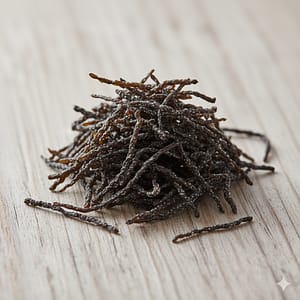- Home
- Hijiki Seaweed (Sargassum fusiforme)

I. General Information
A. Scientific Name:
Sargassum fusiforme
B. Alternative Names:
Hijiki
C. Pronunciation:
hee-jee-kee
II. Sourcing and Origin
A. Source:
Wild-harvested along rocky coastlines of Japan, Korea, and China.
B. Geographic Origin:
Japan, Korea, China
C. Method of Processing:
Harvested, boiled, dried into strands
III. Properties and Uses
A. Physical Properties:
Black, wiry strands; expands greatly when rehydrated
B. Chemical Composition:
Fiber, calcium, iron, magnesium, polysaccharides
C. Primary Uses:
Skincare: Mineral-rich extracts for creams
Haircare: Traditionally believed to darken hair
Wellness: Digestive and bone health support
Culinary: Simmered side dishes, salads
Household: Nutrient booster in cooking
D. Key Benefits:
Rich in minerals, supports digestion, strengthens bones
IV. Safety and Considerations
A. Potential Allergies:
Rare, but high arsenic levels in some hijiki can be concerning
B. Best Practices for Use:
Soak before cooking; simmer with vegetables for flavor
C. Special Precautions:
Some countries caution against excessive hijiki due to inorganic arsenic content
V. Fun & Educational Facts
A. Historical Context:
Traditional part of Japanese Buddhist cuisine (shojin ryori)
B. Did You Know?
Hijiki expands up to 5 times its dry size when soaked
C. DIY Recipe Idea:
Hijiki salad with carrots and soy
Hijiki simmered with tofu
Hijiki rice
